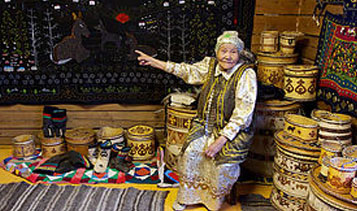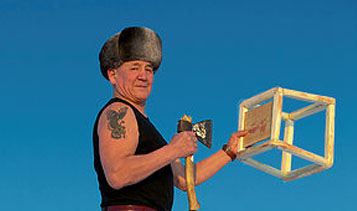
Icebergs. We know them not.
April 15, 2016 | Galya Morrell
Iconic and enigmatic, they are beyond our reach. They are too far, too cold and too foreign. One can’t touch them. One can’t relate to them. And why should one?
In the carousel of our worries, insecurities, aspirations, fears and hopes - icebergs simply don’t fit. We are all too busy to look up into the sky, and it’s so close. So, why icebergs?
I did not know icebergs until I met them. For just a few years, I travelled among them by dog sled, in a small open boat and by foot. I lived among them, I slept among them, I danced among them and I loved among them. Icebergs illuminated my life. They gave me a chance to see the light in the running cracks of their ever-changing ceilings and find clarity that is so evasive in the broken world of the dwellings of mankind. They gave me a chance to take a pause, such a needed one, and see the circle of life in which darkness goes hand in hand with light and in which clocks and calendars become irrelevant.
Icebergs may seem lifeless, but they are far from that. They are homes to millions of tiny and not so tiny creatures, from iron bacteria and snow algae to polar bears and seals. Humans use the icebergs’ top floors as lookouts; from these formidable “penthouses” the locals follow the catch, orient in the chaos of the frozen ocean and judge the seasons. Rather than empty and sterile chunks of ice, icebergs are floating, overpopulated skyscrapers whose residents demonstrate admirable diversity. Iceberg dwellers, some of whom can be seen only under a microscope, spend their entire life cycle here: here they are born, grow up, fall in love, reproduce, and die.
Icebergs, like dinosaurs or woolly mammoths, come from afar. They are born being already hundreds of thousands of years old. Their birth is intense, dramatic, sometimes violent and always lengthy: a separation from the Mother Glacier and gradual sliding into the water can take up to six years. As they free themselves, they can travel long distances, sometimes all the way to the latitudes of their sister skyscraper megapolis - New York City.
Beaten by winds, worn by waves and burnt by the sun, they disintegrate leaving no trace behind. Some go down gradually, some die almost immediately, accidentally, after crashing into another iceberg or land. But some – whose life trajectory keeps them away from warm waters – last a long time, up to half a century.
As they travel, they breathe, releasing bubbles of pure ancient oxygen into the polluted skies of our world. As they melt, they drain the cleanest fresh water on Earth into the salty waves of the world ocean.
Their bones, veins and vessels are full of life that has been formed millennia before our own arrival onto this planet. In their flesh, they carry memories that we humans have in the depth of our genes. We, humans, owe icebergs our existence. Icebergs are our living ancestors. One can talk to them, ask questions or read them like a book. But most of us are too busy to read books, let alone books of Ice Wisdom which gather the dust of time.
Most of the icebergs you will see today at this exhibition are gone. They have transformed into a new entity having added a small bit to the rising sea levels. They are not around anymore, but the memory of our encounters lives in my heart.
Nature – the grand architect, has courage – a courage to create things that will be gone. Nothing, absolutely nothing, will stay at the end: no preparatory drawings, no collages, and no masterpieces. Only memories will stay.
Isn’t that the same with people? Day and night, time, gravitation, elements, and our internal clocks work incessantly on our bodies. Crossing longitudes and latitudes, both icebergs and humans move to a turning point X after which lies the unknown. This point may be seen as an end, but it may be only a culmination in our transformation. It all depends on the direction in which we look.
The longer I travelled, the more I understood that I see icebergs the same way I see people. Old, young, sad, joyful, unbreakable, frail, elegant, kitchy – each has a story of its own. A unique one. They come in different sizes, different consistencies, different colors and different shapes. There are no perfect icebergs as there are no perfect people.
At some point I started giving names to the Icebergs that I knew. I thought, «They will be gone, but the name will tell us the story. And this story will become a legend.»
I have seen many icebergs. Some were small – no bigger than a car. Some were medium size – comparable with a small grocery store. And some were gigantic, taller than 40 story buildings and larger than some independent countries; one feels like a splinter next to one of them.
Most icebergs I met were a shade of white. But some were blue, green, orange, pink, yellow, purple and even black. It’s a game of light, density, salinity and our own perceptions and imaginations.
Some resembled Mauritanian fortresses, and some – the skyscrapers of Manhattan, industrial warehouses of Texas, and spaceships of the future. Some were topped with minarets, others - with onion domes, yet others – with giant solar panels. Winds and currents pave the streets and plazas between them, blow them together and apart, connect them with passable ice bridges and disconnect abruptly, leaving ruins behind.
The more I was looking at Icebergs, the more I was thinking about us – humans. We are the Terrestrials. And therefore we can easily live like mice or birds – in holes and in nests, on top of each other. We can fight self-destructive wars over a patch of soil or rock, which take away thousands of lives yearly. But today, when the Earth’s population has reached 7 billion and when the shoreline keeps receding, we are prompted to rethink: where to live and most importantly – how to live.
For most of us, the wars happening on land are very far away as well, yet we create the illusion that they are so close. An iceberg is no farther away than the land of far away countries. The beauty of an iceberg is that it takes water - which humans cannot live without - and turns it into solid ground.
Yes, we are the Terrestrials. But we are also the Aquiferous. An Aquifer is a body of water that includes permeable rock. Like Icebergs we are mostly made of water, yet we are very solid. Like an Aquifer we are made of a solid that allows water to penetrate our deepest fears, desires, hopes and dreams. Water is not the foreign element for us.
Icebergs are far away. Unlike the sky that is close, we don’t see them, we know them not. But sometime soon they will float much closer to us. Knowing them does not come from touching them, from seeing them, even from tasting them. Knowing comes from the reflection that they give off. Knowing comes from giving that reflection a name.
We are blind as we can’t see the Future, equally - the distant one and the immediate one. We don’t look up into the sky. We don’t need to know Icebergs. But Icebergs can help us to see ourselves better than ever before. They can illuminate our life and engage us with things we choose not to care about. Architect Nature has created Icebergs as giant mirrors in which we may see – if we choose - our own reflection. And if we see them, maybe we will think differently, and maybe - one day – even act differently?
My blogs:




Travels with the Nomad:
October 31, 2015 | Galya Morrell
Matters of Health:
June 10, 2015 | Galya Morrell
Russian Telegraph:
May 1, 2015 | Galya Morrell
Travels with the Nomad:
October 31, 2015 | Galya Morrell
Matters of Health:
June 10, 2015 | Galya Morrell
Russian Telegraph:
May 1, 2015 | Galya Morrell





